Late Autumn Diary 2010
Added on Wednesday 3 Nov 2010
It's that time of year again! The last and most enjoyable harvest of them all! Olive Picking!
This will be our fifth year now, and surprisingly I still get a buzz out of it and never tire of it. We are always aspiring to pick more olives than the year before. Last year we had a bumper crop with 534 kilos making 80 litres of extra virgin olive oil, not bad for 40 trees. Our trees are well known for making good oil in this area, with each neighbours oil slightly different.
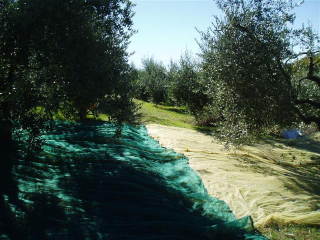 History and Process
History and Process
In years gone by, the olives were picked on St. Catherine's day, 25th November, but as the climate has changed, (global warming or naturally so, I will leave for others to decide), its now usual to pick in the last week of October. As we only have 40 trees, we normally pick by hand and by ourselves which can take on average about 5 days solid picking from 9am till sundown (usually around 5pm). Olives cannot be picked in the rain as it makes them mouldy and they cannot be kept indefinitely. Once you have picked, it is vital that you book into your local 'frantoio' (olive pressing mill) and make sure the olives are pressed within a week to 10 days. We are lucky enough to have a 'grotto' (cellar) built into our land where we store the olives ready to take to the mill.
The Picking/The Harvest
Many of our Italian neighbours, who have more trees and family than us to help out, normally use a mechanical device to shake the trees and therefore harvest quicker, but we feel, and there is some evidence to confirm this, that the machines damage the trees. We also like to pick by hand as it is a very therapeutic and very clean past time. The average number of trees people here seem to have is around 100, give or take a few or so many more like about 1000, even those people living in the town, all seem to retain a piece of land with olive trees somewhere in the country.
Last year we were fortunate enough to have our neighbours children help out which was a godsend! As there didn't seem to be enough hours in the day. It's the best sleeping pill and we are normally asleep by 7.30-8pm!
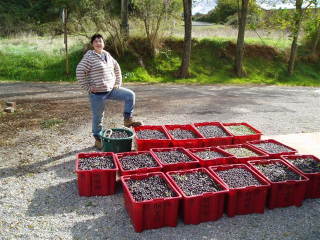 As our trees are located on a terrace, like so many are on the Umbrian landscape, the most tricky part is laying the nets underneath the trees and hammering in bamboo supports so the olives don't all run down the ravine! But it's such a satisfying feeling when you gather all the olives up after picking just one tree, to try and guess if it will fill a full crate. We have small red crates and pink ones (the different colours denote different weights but it's not an exact science!). Years ago they used to put them in sacks and some still do.
As our trees are located on a terrace, like so many are on the Umbrian landscape, the most tricky part is laying the nets underneath the trees and hammering in bamboo supports so the olives don't all run down the ravine! But it's such a satisfying feeling when you gather all the olives up after picking just one tree, to try and guess if it will fill a full crate. We have small red crates and pink ones (the different colours denote different weights but it's not an exact science!). Years ago they used to put them in sacks and some still do.
I remember the first year of picking; we were still living in Glasgow at that time, but had to come over anyway to see our surveyor and the bank. So we picked the minimum we could in the time restraints we had. I couldn't lift, never mind carry a full crate of olives and walk up the terraced hill. When I got back to the hotel I had to have a bath to ease my back and woke up the next day aching, but now apart from premature sleeping!, I can carry full crates up the hill and don't need baths anymore, (that doesn't sound right-of course I still shower!)
We have a mixture of varieties; green and black olives some for eating and some purely for making oil, this produces a better quality of oil and healthier plants. Leftover olives I pickle with garlic and our old olive oil.
Transporting the olives
As I have mentioned in earlier blogs, we have a very temperamental 15 year old fiat panda which does actually hold quite a lot of crates of olives but last year, we had just too many. So we volunteered our neighbours to help us take the crates, they took 4 crates in their car, we had 4 plus the empty olive oil tin in ours, and 4 crates in the neighbour's brother's campervan. A convoy of olives whizzing along to the mill-that sounds almost biblical!
The Pressing-To the Mill and Beyond!
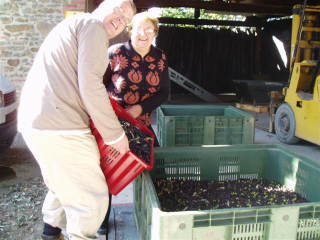 As you can imagine, there are many 'frantoio's' (olive mills) around this area and most of them are modern which lends itself to a quicker process, the oil is ready the same day however, the oil is heated to a higher temperature and therefore impairs the flavour. This method is very popular with the ordinary Italians because they deem it more hygienic, however I beg to differ. We like to go to one that still traditionally presses; there are not that many left. They use stone grinders stacked like records on a record player (for those people of a certain age who will remember LP's and records!). To my ignorance everything is pressed including the olive stone, and gradually the oil is left to seep out over a couple of days. The residue that is left behind, 'mulchin', is probably the best way to describe it, can be obtained free to use on your land. Obviously how much you pay the mill depends on the weight of the olives you brought. We are normally around 150 euros. You must take along with you, a 50 litre aluminum tin (like a milk churn) for them to fill and remember to put your name on it, of course our names stick out a mile! The most important thing to bring is actually your 'codice fiscale' (A combination of your tax code and national insurance number). In Italy you need this number for everything from having electricity connected to your home to ordering Sky television!
As you can imagine, there are many 'frantoio's' (olive mills) around this area and most of them are modern which lends itself to a quicker process, the oil is ready the same day however, the oil is heated to a higher temperature and therefore impairs the flavour. This method is very popular with the ordinary Italians because they deem it more hygienic, however I beg to differ. We like to go to one that still traditionally presses; there are not that many left. They use stone grinders stacked like records on a record player (for those people of a certain age who will remember LP's and records!). To my ignorance everything is pressed including the olive stone, and gradually the oil is left to seep out over a couple of days. The residue that is left behind, 'mulchin', is probably the best way to describe it, can be obtained free to use on your land. Obviously how much you pay the mill depends on the weight of the olives you brought. We are normally around 150 euros. You must take along with you, a 50 litre aluminum tin (like a milk churn) for them to fill and remember to put your name on it, of course our names stick out a mile! The most important thing to bring is actually your 'codice fiscale' (A combination of your tax code and national insurance number). In Italy you need this number for everything from having electricity connected to your home to ordering Sky television!
With all these frantoio-the unwritten rule is that at least 'due quintalle' is needed which is roughly 300 kilos, otherwise the oil will go into the 'communal pot', so what is returned to you is a blend which isn't so bad, but there is nothing like getting your very own! and luckily because we have such fruitful trees this has never happened to us, touch wood!
All the crates get poured into one big 'quintale' crate which rests on the weighing machine, this will then give the weight, its always an anxious and exciting moment for us to find out whether we have picked more than last year-it does seem every year we have increased our volume so we are always really pleased.
When you first see and taste the newly pressed oil-there is nothing quite like it. It's so very green and in Umbria specifically very peppery. For the first few days you dip it with some toasted Italian bread as Craig Revel-Horwood would say De-Li-cious! Then after a couple of days the colour begins to change to darker green to eventually greeny yellow-a few months on. Extra Virgin Olive Oil can keep on average for 2-3 years.
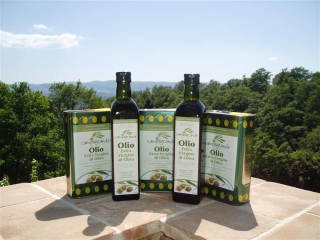 Glasgow Deli's
Glasgow Deli's
I have returned to Glasgow on a number of occasions with our newly pressed extra virgin olive oil to let some of the west end delis try it and all of them really love it and want to buy it which is the best feeling in the world when someone wants to buy something you have produced, fortunately they like the fact that we are a very small producer and its all done organically and by hand but unfortunately for those reasons, we are not able to transport it at a cost effective price. So we are more than happy to sell to our guests and other peoples guests over here. I had a Swedish chef come and visit who lives here part of the time but has a shop in London and a stall at Norfolk Farmers Market. She was very interested in my oil (she sampled it previously from another guest and loved it). She wants to buy my new oil, so she wants to know how many litres we get this year-so watch this space!
Rest of our news
In August, we had a couple who live and work in Rome but who are originally from citta della pieve, wanted information on our rooms, it just so happens my rooms had just been made so I invited them in to have a look -they loved them! They were having their little baby baptized in town so she booked all 3 rooms for her friends and family for October which was brilliant-she joked they wont be allowed to cancel! which they didn't. They were all very complimentary on the decor and size of the rooms and David's cake. We also have bookings for this Halloween weekend as the 1st of November (All Saints Day) is a holiday here. A few of them have stayed before. and for the very first time we have a booking for next July! That's what I call forward planning!
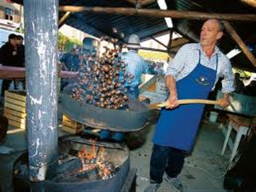 Sagra di Castagne-festival of chestnuts
Sagra di Castagne-festival of chestnuts
On our way to the Sagra we passed many people on the road parking their cars in the most obscure places-it was of course, mushroom season!. One of our neighbours came by to ask if we had picked any yet, she had obviously forgotten we are FOREIGN! Anyway we explained we wouldn't know where to look and wouldn't know what to pick. The next day she brought us a whole bag of porcini mushrooms! We are still none the wiser about where to go, but next year I will follow them!
As you probably all know there is a 'sagra' (festival) for everything in Italy. Two weeks ago we were kindly taken to our local chestnut festa, where you can sample them in many varying forms, from roasted to vacuumed packed to chestnut cake. We opted for the roasted-will-eat-them-now-variety! They were delicious washed down with a glass of Lambrusco!
Its also walnut season but our walnuts are always a bit of a hit and miss-I actually didn't know what they were at first as they are coated in a black covering and then black gooey tannin. Just as Mother Nature intended! It's not until you scrub the goo off (a messy job) that you discover the walnut and the shell is a little darker than expected. Apparently when we buy them back home at Christmas (seasonally late) they bleach the shell so that they all the same uniform colour. I rest my case!
As I write in the middle of this years olive pick, a combination of a very harsh winter and a severely needed pruning, we may not get our quota for this year but watch this space!
Next time on November's Campogrande Diary-the 'nespoli' (medlar) will be ready to pick and to start hard landscaping the front area to make a patio/gazebo for guests and more teaching, Now.....where did I put my sledgehammer!.................
.






